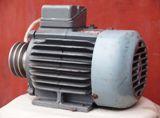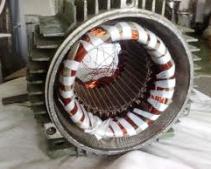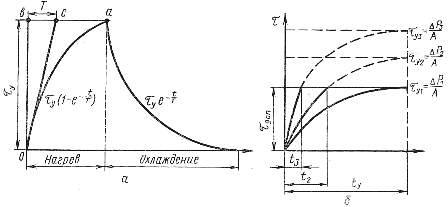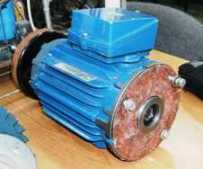Thermal conditions and rated engine power
 When the electric motor runs, it loses to cover what part of the consumed electrical energy is wasted. Losses occur in the active resistance of the windings, in the steel when the magnetic flux changes in the magnetic circuit, as well as mechanical losses due to friction in the bearings and friction of the rotating parts of the machine against the air. At the end, all the lost energy is converted into heat energy, which is used to heat the engine and dissipate into the environment.
When the electric motor runs, it loses to cover what part of the consumed electrical energy is wasted. Losses occur in the active resistance of the windings, in the steel when the magnetic flux changes in the magnetic circuit, as well as mechanical losses due to friction in the bearings and friction of the rotating parts of the machine against the air. At the end, all the lost energy is converted into heat energy, which is used to heat the engine and dissipate into the environment.
Engine losses are constant and variable. The constants include steel losses and mechanical losses in windings where the current is constant, and variable losses in motor windings.
In the initial period after switching on, most of the released heat in the engine goes to increase its temperature, and less goes to the environment. Then, as the engine temperature rises, more and more heat is transferred to the environment, and there comes a point when all the heat generated is dissipated into space.Thermal equilibrium is then established and further increase in engine temperature stops. This engine warm-up temperature is called steady state. The steady state temperature remains constant over time if the engine load does not change.
The amount of heat Q that is released in the engine in 1 s can be determined by the formula

where η- engine efficiency; P2 is the motor shaft power.
It follows from the formula that the greater the load on the engine, the more heat is generated in it and the higher is its stationary temperature.
 Experience with the operation of electric motors shows that the main cause of their malfunction is overheating of the winding. As long as the temperature of the insulation does not exceed the permissible value, the thermal wear of the insulation accumulates very slowly. But as the temperature rises, the insulation wear increases sharply. Practically believe that overheating of the insulation for every 8 ° C cuts its life in half. So, a motor with cotton insulation of windings at rated load and heating temperature up to 105 ° C can work for about 15 years, when overloaded and the temperature rises to 145 ° C, the motor will fail after 1.5 months.
Experience with the operation of electric motors shows that the main cause of their malfunction is overheating of the winding. As long as the temperature of the insulation does not exceed the permissible value, the thermal wear of the insulation accumulates very slowly. But as the temperature rises, the insulation wear increases sharply. Practically believe that overheating of the insulation for every 8 ° C cuts its life in half. So, a motor with cotton insulation of windings at rated load and heating temperature up to 105 ° C can work for about 15 years, when overloaded and the temperature rises to 145 ° C, the motor will fail after 1.5 months.
According to GOST, insulating materials used in electrical engineering are divided into seven classes in terms of heat resistance, for each of which the maximum permissible temperature is set (Table 1).
The permissible excess of the temperature of the motor winding above the ambient temperature (in the USSR + 35 ° C is accepted) for heat resistance class Y is 55 ° C, for class A — 70 ° C, for class B — 95 ° C, for class I — 145 ° C, for class G above 155 ° C.The temperature rise of a given engine depends on the magnitude of its load and operating mode. At an ambient temperature below 35 ° C, the motor can be loaded above its rated power, but so that the heating temperature of the insulation does not exceed the permissible limits.
Material characteristic Heat resistance class Maximum permissible temperature, ° C Non-impregnated cotton fabrics, yarns, paper and fibrous materials of cellulose and silk Y 90 The same materials, but impregnated with binders A 105 Some synthetic organic films E 120 Mica, asbestos and materials of fiberglass containing organic binders V 130 The same materials in combination with synthetic binders and impregnating agents F 155 The same materials but in combination with silicon, organic binders and impregnating compounds H 180 Mica, ceramic materials, glass, quartz, asbestos, used without binders or with inorganic binders G more than 180
Based on a known amount of heat B dissipated when the engine is running, an excess engine temperature τ° C above the ambient temperature can be calculated, i.e. superheat temperature

where A is the heat transfer of the engine, J / deg • s; e is the base of natural logarithms (e = 2.718); C is the thermal capacity of the engine, J / city; τО- the initial increase in engine temperature at τ.
Steady-state engine temperature τу can be obtained from the previous expression by taking τ = ∞... Then τу = Q / А... At τо = 0, equality (2) takes the form

Then we denote the ratio C / A to T

where T is the heating time constant, s.
The heating constant is the time it takes for the engine to heat up to steady state temperature in the absence of heat transfer to the environment. In the presence of heat transfer, the heating temperature will be less than and equal to

The time constant can be found graphically (Fig. 1, a). To do this, a tangent line is drawn from the origin of the coordinates until it intersects with a horizontal straight line passing through point a, corresponding to the temperature of stationary heating. The segment ss will be equal to T and the segment ab will be equal to the time Ty during which the engine reaches a steady state temperature τу… It is usually taken equal to 4T.
The heating constant depends on the rated power of the motor, its speed, design and cooling method, but does not depend on the magnitude of its load.

Rice. 1. Engine heating and cooling curves: a — graphical definition of the heating constant; b — heating curves at different loads
If the engine, after heating up, is disconnected from the network, from that moment it no longer generates heat, but the accumulated heat continues to dissipate into the environment, the engine cools down.
The cooling equation has the form

and the curve is shown in Fig. 1, a.
In the expression, To is the cooling time constant. It differs from the heating constant T because the heat transfer from the engine at rest differs from the heat transfer from the running engine.Equality is possible when the engine disconnected from the network has external ventilation.  Usually the cooling curve is flatter than the heating curve. For engines with external airflow, To is approximately 2 times greater than T. In practice, we can assume that after a time interval of 3To to 5To, the engine temperature becomes equal to the ambient temperature.
Usually the cooling curve is flatter than the heating curve. For engines with external airflow, To is approximately 2 times greater than T. In practice, we can assume that after a time interval of 3To to 5To, the engine temperature becomes equal to the ambient temperature.
With a correct selection of the nominal power of the motor, the steady-state overheating temperature should be equal to the permissible temperature rise τaddcorresponding to the insulation class of the winding wire. The different loads P1 <P2 <P3 of the same engine correspond to certain losses ΔP1 <ΔP2 <ΔP3 and the values of the established overheating temperature (Fig. 1, b). At rated load, the motor can operate for a long time without dangerous overheating, while when the load increases to the permissible switching time, it will be no more than t2, and at power no more than t3.
Based on the above, we can give the following definition of the engine's rated power. The rated power of the motor is the shaft power at which the temperature of its winding exceeds the ambient temperature by an amount corresponding to the accepted overheating standards.
